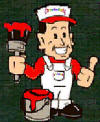- Doors create a beautiful first impression.
- Wood costs are rising - it's more expensive to replace your existing door.
- A deteriorated entry door detracts from your otherwise well maintained yard.
- Sprinkler systems can gradually damage your doors.
- Arizona heat dries out wood doors and cracks the surfaces.Our team of experienced finishers will stain your fiberglass door to look just like real wood. You may choose from our wide variety of paint colors, or select one of our seven rich shades of stain that we offer. Then the finish is baked on to assure lasting beauty. From one door to one hundred, call us for further information Fiberglass DoorMany of our customers tell us that their wood door never looked better. Our staining expertise allows us to closely match your original door color. However, if you want to update the look of your home, we can work with you or your decorator to make your door the color of your choice and enhance the appearance of your home entrace.
- If you are looking for something unique --our specialized techniques of door refinishing, door glazing, door antiquing and door distressing may be the answer. Our finishing process gives your door the best possible protection against the elements.
Penetrating Wood Finishes
Penetrating finishes are absorbed into the wood pours with very little remaining on top. All of the penetrating finishes are wipe-on types, even if they are initially applied with a brush. The excess is removed after a short period, usually 5-10 minutes.
Examples;
- Linseed Oil – Mostly used on exterior wood siding and log homes.
- Tung Oil – Interior use is most common, can be used on food contact surfaces.
- Danish Oil- Can be used on interior doors and trim.
Tung Oil and Linseed Oil are called drying oils. This type of wood sealer can take a long time to dry to the touch. Linseed oil can take days in most cases and remain rather soft for a very long time. Typical use is outside; example would be a log home.
Applying Linseed Oil is easy although messy. Tung Oil has been used for centuries and is an excellent wood sealer for interior and many exterior wood surfaces. Applying Tung Oil is very simple with maintenance being as easy as applying another coat.
Danish Oil is a combination of Tung Oil and varnish with pigments add for color. Danish Oil is applied in the same way as the other penetrating finishes.
Before After
Film Forming Wood Finishes
Film forming wood topcoats have limited penetrating capabilities and remain on top of the wood. They can be the toughest clear topcoats but not necessarily the best for every project.
Examples;
- Varnish (Brush-On and Spray) - Varnish is similar to the drying oils but have specialized resins that provide faster drying and a much harder finish. These are available in a wide array of sheens and degrees of hardness. Plus, some varieties are great for exterior use. Most applications are a multi-step process. Applying varnish produces a tough film on the surface of the wood.
- Polyurethane (Brush-On and Spray) - Polyurethane is very popular now days, available everywhere and not to expensive. This clear topcoat is best suited for new wood applications. Basically polyurethane is a plastic coating, with interior and exterior uses. Some poly's can also be tinted for special effects. Applying polyurethane is the same as varnish, needing a few steps to do it right.
- Acrylic Urethane (Brush-On and Spray) - Acrylic Urethane is rather new to the market. Best suited for interior use, but exterior varieties are now being produced. I like this type of finish. It doesn’t smell bad and dries fast. The best part is it cleans up with soap and water. Usually takes a few coats to achieve a good film thickness. Applying acrylic urethane is easy, can be brushed or sprayed.
- Lacquer (Spray Only and Brush-On) - Lacquer is a common interior wood finish that is available with varying degrees of hardness. Typically this is a spray only finish. Spraying lacquer will require some finesse. Brushing lacquers are rarely used today with so many other alternatives.
- Catalyzed Clear Topcoats (Spray Only) - Catalyzed topcoats are a little different than anything else you will ever encounter. These are 2 part wood finishes that are difficult to use. Usually very hard and durable, this is a common finish used on cabinets. Rarely used by the do-it-yourselfer, but still a good choice for wood surfaces that needs extra protection and abrasion resistance.
- Shellac (Brush-On) - Shellac is a natural resin dissolved in denatured alcohol and is applied with a brush. Shellac has good durability but is a little difficult to apply, it dries within seconds. Even though this is a natural resin it isn’t recommended for food contact surfaces.
